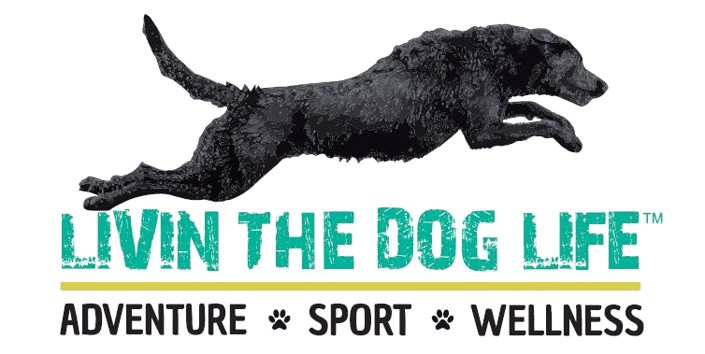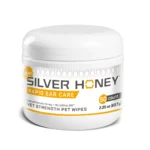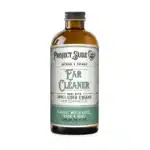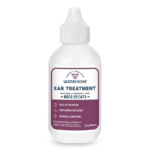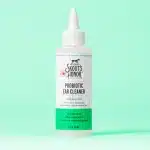Your dog relies on their ears to help them better understand the world around them. Make sure to keep your dog’s ears clean by using gentle cleaners with aloe to help soothe the skin and your dog will feel more comfortable. Inspect the ears regularly.
Take care not to expose your pet to loud noise. “Depending on the noise, dogs’ sensitivity to sound can be similar to our own, or hundreds of times more sensitive” – Source: National Geographic, The Genius of Dogs
An important part of caring for your dog is checking their ears regularly. Some dogs, such as those with ears that hang down, require frequent gentle ear cleaning to avoid infections. Talk with your veterinarian about the best way to clean your dog’s ears. Other dogs have naturally clean ears. Overcleaning a dog’s ears can also cause problems. It’s important to understand what your dog’s ears look like when healthy and what they look like when they need to be cleaned. The key to ear health is keeping the pH balance in their ears stable.
We suggest natural organic cleaners w a soothing moisturizer element that won’t dry out the sensitive skin of the ear, be very careful not to use or overuse any chemical that would be damaging to this sensitive thin skin area.
If a dog’s ears show signs of infection, they need to see a veterinarian. It is more responsible to use a topical treatment first versus a systemic product, mention this to your veterinary to get their opinion on best treatment. It can be harmful to try to clean an infected ear without proper review and consultation by a pet care specialist. “Some dogs show no symptoms of ear infection aside from a buildup of wax and discharge in the ear canal. But ear infections often cause significant discomfort and affected dogs may show signs as:
- Head shaking
- Scratching at the affected ear
- Dark discharge
- Odor
- Redness
- Pain
- Itchiness
- Crusting or scabs in the ears
- Any of these items listed above can be a symptom of the dog’s indication of an allergy to food, treats and drugs. If your dog is having compulsive problems, you may want to first start by stopping the feeding of treats and a review w your veterinarian to stop use of any medicines or drug’s (such as flea & tick preventatives) as well as starting on a basic home or simplified single-protein diet.
- When a dog’s body is trying to eliminate a substance, their body is allergic to it naturally chases the substance out to the skin primarily in the mucous membrane areas such as the ears, paws, armpits, nose and eye region. This is a natural defense to eliminate the substance from the body which can cause itching and/or irritation. Keep in mind – It Does Take Time for the substances to eliminate from the body and the skin to heal, so give it time – you should see hopeful progress during the elimination process. Allergy testing may help provide insight into the problem also.
If your dog is showing any of these signs, it’s important to visit your veterinarian as soon as possible. Do not try to treat ear infections at home without an initial review and consultation. Most uncomplicated ear infections generally resolve within 1-2 weeks once appropriate treatment begins. But severe infections or those due to underlying conditions may take months to resolve. Below are some GENTLE topical cleaning and treatment solutions that may be the best first step towards a safe and effective solution to discuss with your veterinarian.
As with most diseases, prevention is always best. Excess moisture is a common cause of ear infections, so be sure to thoroughly dry your dogs’ ears after swimming and bathing. If your dog is prone to ear infections, identifying and managing any underlying causes such as allergies can help prevent new infections from incurring. Cleaning your dogs’ ears at home can also help prevent ear infections.” — Source: AKC
Another big factor in preventing ear infections is feeding your dog healthy food and treats. IMPORTANT – We suggest not giving your dog too many treats and if you do use treats, only use those that have a limited number of natural ingredients and are considered a High-Quality Treat. Natural ingredients may include blueberries, pumpkin, oatmeal, molasses, peanut butter and other natural ingredients. Try to stay away from: Color additives, Flavor additives and Preservatives. We suggest using simple all natural, very limited high-quality natural ingredient treats only.
Check food and treat labels for the ingredient “BHA – butylated hydroxy anisole is an antioxidant that is sometimes used as a preservative in dog food and treats. The Department of Health and Human Services warns that BHA is ‘reasonably anticipated to be a human carcinogen’. According to the National Institute of Health, BHA in the diet has been found to consistently produce certain types of tumors in laboratory animals.” – Source: Dog Food Advisor
“Dogs who live a more natural lifestyle are less likely to develop ear infections. Try to minimize exposure to chemicals in your dog’s environment, indoors and outside. You can reduce your dog’s exposure to toxins by choosing natural shampoos to bathe your dog and avoiding toxic cleaning products in your home.” – Source: Source Dogs Naturally Magazine
There are many GENTLE all-natural ear cleaning products available; use something that is gentle as the skin in the ear is sensitive.
Using soft cotton swabs are a good drying product. Consult with your veterinary on proper cleaning procedures.
